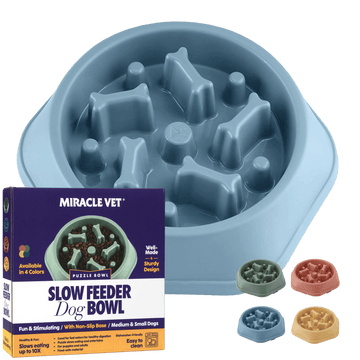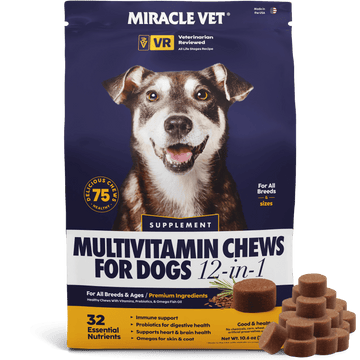How to put weight on a dog
Is your dog underweight? If so, they could be suffering from all sorts of health problems like low energy, lethargy, vomiting or diarrhea, low muscle mass, and a dull coat.
Of course you don’t want that for your dog. You want them to get back to a normal weight so they’ll have the energy they need to run, play, and feel happy & healthy again.
But putting weight on a malnourished dog isn’t always easy—especially since many underweight dogs have a decreased appetite and don’t necessarily want to eat more.
So what do you do in that case?
Well, here at Miracle Vet we know a thing or two about putting weight on a dog. And in this post we’re sharing 7 tips you can use to bring your dog up to a normal weight—naturally and healthily.
1) Record Your Dog’s Weight
In order to find out how much food your dog needs to gain weight, it’ll be important to keep track of your dog’s weight on a regular basis—try to do this once a week.
This way, you’ll be able to look back over time and see which dietary changes led to an increase in weight…and which ones didn’t. And then you can adjust their diet accordingly.
2) See A Veterinarian & Deworm Your Dog
Before you do anything drastic, make sure to consult with a vet and get their opinion. Remember that your dog’s low body weight may have a medical cause, which means there may be an underlying health issue that needs to be addressed before your dog will be able to get back to a healthy weight.
Some illnesses that could be causing weight loss include cancer, hepatitis, or diabetes. Intestinal parasites are another common cause of low body weight, so definitely ask your vet to do a fecal test and have your dog dewormed if they find signs of intestinal parasites.
When you’ve finished ruling out any health issues, you can proceed to the next step.
3) Figure Out How Much Your Dog Should Weigh
Many people don’t have a good idea of what their dog is SUPPOSED to weigh. So before you start to feed your dog an increased calorie diet, make sure you know what your dog’s ideal weight should be in the first place.
Here’s a resource that will help you to determine your dog’s ideal weight.
4) Don’t Forget To Exercise!
Anytime you increase your dog’s calorie intake, you’ll want to make sure they’re getting exercise too. Remember, you don’t want your dog to gain too much unhealthy fat—instead you want your dog to maintain a healthy combination of fat & muscle. Which means that you’ll want to incorporate a good exercise routine.
Exercise can also help fight against muscle wasting (which can be a side-effect of malnourishment). It can also help stimulate your dog’s appetite, which is important when they need to gain weight.
A word of caution, however: if your dog is currently underweight, then you probably don’t want to start them on a rigorous exercise plan right away. Start them off easy, and increase the intensity slowly and gradually. And if your dog has any medical conditions, then always ask your veterinarian how to best incorporate an exercise routine without causing any injuries.
5) Add Calories To Your Dog’s Diet
Out of the 7 steps in this article, this one is by far the most important for bringing your dog back up to a healthy weight. If you want your dog to gain weight, you have to feed them more calories!
It sounds obvious, but it’s so important that it’s worth pointing out.
And there are several ways you can achieve this. Here are a few different strategies:
- Feed your dog an extra meal each day. If you currently feed your dog once a day, feed them twice. Or if you feed them twice, give them 3 meals.
- Add extra food to your dog’s bowl each meal. If you give them 1 cup, give them 1½ cups. Just make sure you don’t give them so much that they overeat and get sick.
- Change your dog’s food to a more calorie-dense variety. Just make sure it’s also nutrient-dense.
Keep in mind that when you change your dog’s dietary habits, you’ll also be changing their bathroom habits. So you may need to add in an extra walk as a result.
Another option is to supplement your dog’s diet with a small amount of healthy human food—like chicken, lean beef, or tuna. Just be careful not to feed them anything they shouldn’t eat! Which brings us to…
6) Foods to Avoid
While it’s important to feed your dog an increased calorie diet, there are some foods that can cause serious side effects in dogs—like vomiting, abnormal heart rhythm, seizures, and even death. So be careful to avoid feeding these foods to your dog:
- Alcohol
- Avocado
- Chocolate, coffee, and caffeine
- Citrus
- Coconut and coconut oil
- Grapes and raisins
- Macadamia nuts
- Milk and dairy
- Nuts
- Onions, garlic, and chives
- Raw or undercooked meat, eggs, and bones
- Salt and salty snack foods
- Xylitol (a common sweetener)
- Yeast dough
Steer clear of these foods to make sure your dog stays healthy as they gain weight.
7) Add Supplements
There’s one last way to get more calories in your dog’s diet—and this one is a really convenient option anytime you’re busy, short on time, or otherwise in a hurry.
And that is to use a high-calorie supplement to get more healthy calories in your dog’s diet.
A great example that we offer right here at Miracle Vet is our All-Natural Weight Gainer. It’s a liquid weight gainer supplement that’s packed full of nutrient-dense calories like fish oil, whey protein, and over 23 essential vitamins & minerals. You might also consider our High Calorie Chews, a tasty treat to give extra calories on the go.
It’s a fantastic way to help put weight on your dog, without bloating their diet with empty calories.
So give these 7 tips a try with your underweight dog, and watch as they slowly but surely reach a healthy, natural weight!











